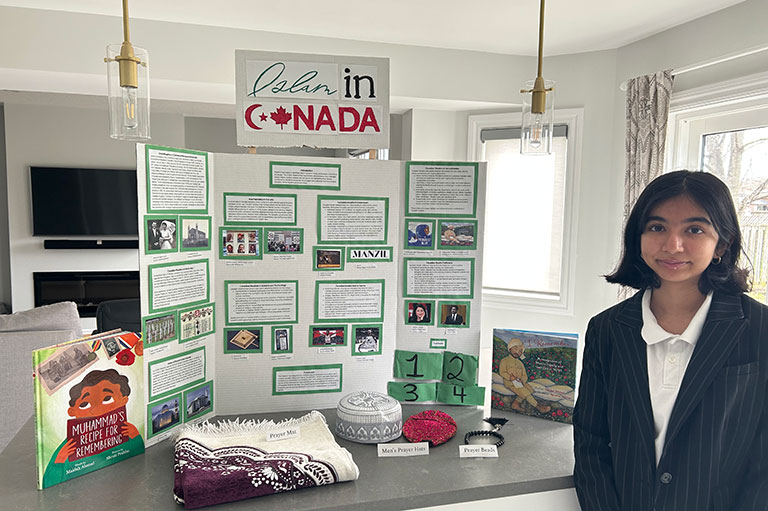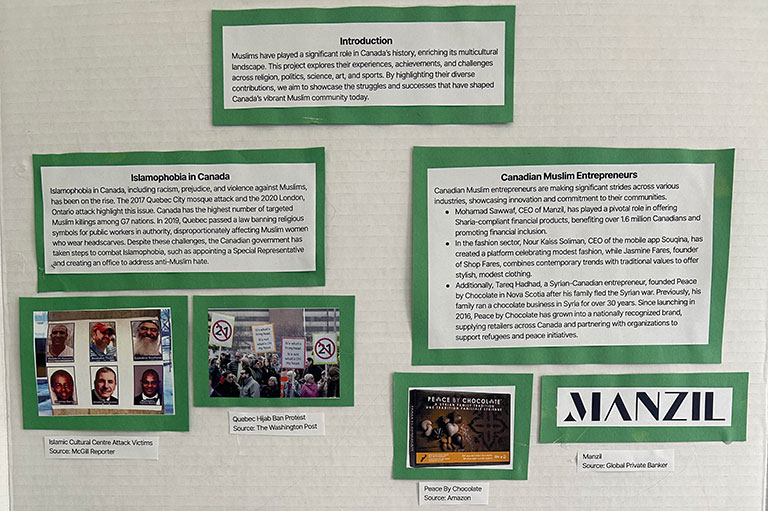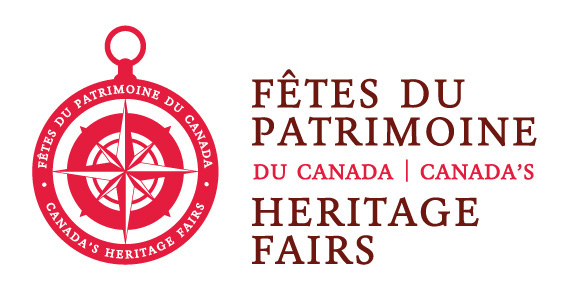Zoha N.

Islam in Canada
Zoha N.
Simcoe County Regional Heritage Fair
Midhurst, ON
I discovered that although Muslims have been part of Canada since the 1800s, their stories are often overlooked. Today, the Muslim community is frequently seen as newcomers, as people who take from Canada without giving back. My research proves otherwise.
Muslims have been present in Canada even before Confederation. Early pioneers like James and Agnes Love, the first documented Muslims who arrived from Scotland in 1851, helped lay the foundations of Muslim life in this country. During World War I, Muslim Canadians like Private Hasan Amat served in the Canadian army, demonstrating courage, loyalty, and sacrifice for their King and country. The Canadian landscape itself reflects Muslim contributions, with landmarks like the Al Rashid Mosque in Edmonton—Canada’s first mosque—its domes and pillars rising as symbols of faith and belonging.
Today, Canadian Muslims continue to make meaningful contributions in every field. In science, Dr. Naweed Syed became the first to connect brain cells to a computer chip. In business, Tareq Hadhad built Peace by Chocolate, a symbol of hope and resilience. In sports and the arts, Muslims are earning global recognition. Despite facing Islamophobia and challenges like Quebec’s ban on religious symbols, Canadian Muslims remain strong, resilient, and committed to building a better future for themselves and fellow Canadians. This project helped me truly understand that Muslims have always been part of the Canadian story. Their impact is vital, and recognizing it is essential to building a more accurate, inclusive vision of Canadian history and identity.
What sources and evidence did you consult for your project? What different perspectives did they provide on your topic?
For my project, I consulted a variety of sources, including newspaper articles, books, websites, and interviews with members of my local Muslim community. Newspaper articles and websites provided current and historical accounts of Muslim contributions and challenges in Canada, including issues like Islamophobia and debates over religious freedom. Books gave me in-depth information about key historical events, such as the establishment of the Al-Rashid Mosque and Muslim participation in the World Wars. Most importantly, interviews with members of the local Muslim community offered personal perspectives that brought the research to life. These conversations highlighted how national issues affect individuals on a local level and revealed diverse views within the Muslim community itself.

What is the historical significance of your topic?
The topic of Canadian Muslims holds major historical significance as it highlights a long-overlooked part of Canada’s multicultural development. Early Muslim immigrants in the 19th and early 20th centuries faced hardship, exclusion, and even internment—yet they laid the foundation for Muslim life in Canada. For example, Muslims from the Ottoman Empire were classified as “enemy aliens” during World War I, leading to the internment of 205 Ottoman nationals. At the same time, 22 Muslims served in the Canadian military, including Pte. Hasan Amat, who gave his life in battle. These contrasting experiences reveal early struggles for belonging and recognition.
The long-term impacts of these early efforts are seen today in the growth and influence of the Muslim population across all sectors of Canadian life. From just 13 Muslims in the 1871 census to 1.8 million (4.9% of the population) in 2021, the Muslim community has become one of the most diverse and educated groups in Canada. Their growing presence has led to the establishment of 755 mosques across the country. These institutions help preserve culture, strengthen communities, and promote interfaith understanding.
All Canadians—whether Indigenous to this land or newcomers—are learning to live together by understanding and respecting each other’s ways of life with peace and tolerance.
Why did you choose this topic?
I chose this topic because, as a Canadian Muslim, my identity has always been integral to who I am. Throughout my life, I’ve rarely seen my faith and community reflected positively in the media or in the stories we tell about Canadian history. Too often, when Muslims are mentioned, it’s within the context of conflict or controversy, and that takes a toll. It shapes how others view us and, perhaps more damagingly, how we view ourselves. I wanted to change that narrative. I wanted to uncover and share the stories of Canadian Muslims who have made meaningful, selfless contributions to this country—stories that deserve to be remembered, respected, and celebrated.
This topic matters to me because I know the profound impact representation has. When young Muslim Canadians see their communities portrayed with pride and dignity, it empowers them to truly feel they belong. And when others learn about these contributions, it breaks down harmful stereotypes and fosters understanding.
Through this project, I hope to educate and bring people closer together, reminding us that Canadian history is not only more diverse but also far more inclusive and inspiring than we often recognize. When I see the propaganda and harmful narratives directed toward the Muslim community, it deeply saddens and hurts me. The constant misrepresentation and hostility toward my faith can be overwhelming. It’s painful because it affects not only how others see us, but how we begin to see ourselves. That’s why I felt so strongly about creating positive media—media that showcases the true, beautiful contributions of the Muslim community, highlighting the compassion, resilience, and love we have to offer. It’s my way of fighting back against hate with truth, hope, and positivity.

